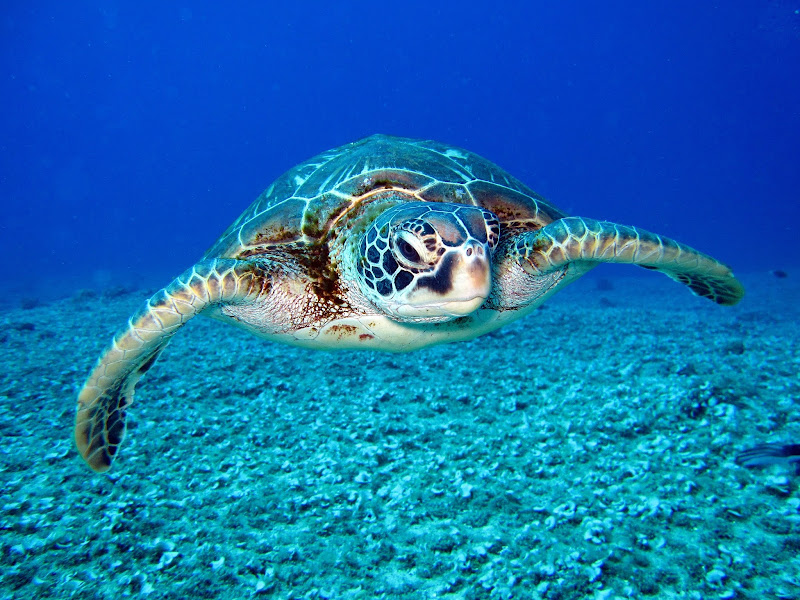I grew up on the eastern shore of Maryland, between the Chesapeake Bay and the Atlantic Ocean. Childhood past times included crabbing, inlet water adventures, and learning about our various forms of sea-life through our local nature centers. Now living in North Carolina Coast habitat, I have encountered the beautiful sea turtle again and have learned even more about her nesting habits! This week, while taking an evening stroll, I encountered the Wrightsville Beach Sea Turtle Project Group helping a nest of babies make their way into the ocean! This prompted me to share all things Sea-Turtle with you so that perhaps, the next time you are on a beach, you will take care and watch out for these precious creatures.
Sea creatures are exquiste. Sure, up close encounters of certain varieties (ahem, sharks) can be scary, but remember- we are entering into their territorty the minute we set foot in water. (I just wouldn't be standing or swimming around a pier at dusk, which is normal feeding time for such dangerous creatures).
One of my favorite creatures is the sea-turtle. Sea-turtles are wonderful endangered beings that can teach us a lot about our eco-systems and life in general. There are seven different types of sea turtles out in the world, but only a couple frequent our Carolina Shores. Remember Crush, from Finding Nemo? That dude was a Pacific Green Sea Turtle, riding the waves in the Eastern Australian Current with his friend, the Flatback.
Eastern Green, Loggerheads, Hawksbill, Olive Ridley, and the most endangered, Kemps Ridley, can all be found in both cool and warm waters. Over here in NC, the most that frequent our waters are loggerheads, Eastern Greens, and the occasional especially endangered Kemps Ridley sea turles!
Why are the endangered? Human Pollution, Fishing, and Natural Selection are all reasons. Sea Turtles have a heck of a time surviving in their habitats, let alone the imprint of the humans.
Perhaps you have visited the beach recently and noticed a switch from plastic straws to paper? Or no straws at all? All trash, but especially plastic straws are harmful to all sea creatures, but for turtles- its even more dangerous. Turtles thrive on instinct- and most of their instinct instructs them to eat fish: small fish, small crustuceans, jellyfish, etc. Turtles can't distinguish between plastic or food, so they eat whatever they see cause their instinct tells them too! Plastic, like straws, can also get stuck in their shells, damaging their organs, shortening their life spans.
Natural Selection? How does that impact Sea Turtles? Well, remember, the sea is FULL of predators! Someone is always someone else's food! From the time sea-turtles are hatched, to the time they become adults and beyond- they are always in danger of being eaten by someone bigger than them!
So let's talk about hatching! Female Sea Turtles lay their nests along the shores of beaches, usually close to dunes. Momma's crawl up their chosen shore (usually the same one, or close to the same one they were born at) during the night, as the risk of predators is lower. Using her back flippers, she will dig a hole about 2.5 ft deep, lay approximately 100 eggs, cover her nest up, perhaps try to distract predators by making a "pretend" nest near her nest, and waddle back out to sea! Momma Turtles are typically about 30 years old when they begin making these treks up to the shore. It takes a LOT of energy and they can do this 3-6 times per season, laying around 600 eggs! Turtle nesting season is between Mid- May and August, but the hatchings can take place from Mid- July to October. That's right- it takes about 60 days for turtle nests to hatch once momma lays her eggs! Now, momma sea turtle doesn't hang around either- she heads back out into the ocean for her next adventure!
Approximately 1 out of the 100 eggs in each nest will survive to adulthoood! Remember, we classify adult turtles as about 30 years old! If they survive the odds, turtles will live to approximately 100 years old. Turtles are in danger before they even hatch too! Land Predators like birds and coyotes, Standing Water, High Tides/ Hurricanes all threaten the development of eggs before their 60 days is complete! Once baby turtles hatch, typically at night, they are no bigger than a ping-pong ball! As they make their way back into the water, their instincts kick in to help them survive in the best ways they can!
So what can we do to aid these marvelous creatures? First off, check out your favorite beach's Turtle Project Group. Over here in Wilmington we have several:
Turtle Projects and Conservancy Groups exist all up and down the coast! Over in Surf City, the Karen Beasley Sea Turtle Rescue and Rehabilitation Center assists to protect and care for harmed sea turtles as well as educate the public about these creatures. Each Project works with the NC Wildlife Resources Commission to ensure safe practices are used when caring for nests, turtles, and working with the general public.
 |
| Kure Beach, NC Turtle Nest hatched Thurs. Aug 20th early AM! |
These Projects are made up of committed volunteers that care for nests, protecting turtles from harm, helping hatchlings make their way back into the public, and educate people on the life of turtles. Project Groups put up fencing, caging, or other materials to deter animals and humans from messing with the turtle eggs. Groups aid in helping hatchlings go into the ocean by ensuring a safe path to the ocean, using red light rather than human light, and works to get people to turn off their lights along beach fronts. Most volunteer hours are spent late at night or super early in the morning to check on nests, assist when needed, and inform conservacy or wildlife rescue groups about turtle needs.
Let's talk about light for a minute! Natural Light is moonlight. Sea Turtles are guided by moonlight- it helps them to know where to go- whether its the land or water. Both mommas and babies get confused by articifical light, so that is why its important to turn off your beach front lights at night. Otherwise, babies or mommas might go the wrong way.. and they need the sea to survive! So make sure you turn off your lights, don't use your camera flashlight or photo apps at night on the beach, and instead find red lights to use on your nightly walks!
Conservancy and Project groups also help Wildlife Resources track our Sea turtles by tagging them! Tags are like GPS monitors that can help us locate turtles, see where they nest and how they ride the waves! Most turtles like to return to their birthplace for nesting, but as proven by these monitors, some do- but some don't and travel up and down their coasts! We still have a lot to learn about sea turtles, especially during their "lost" years in the first 30 years of life. We don't know much about where they go or what they do during that time. But we do know that our eastern sea turtles do not like cool waters, so when it gets too cool in the atlantic, they have a tendency to head towards warmer climates.
Conservancy and Project groups do keep track of turtles and nesting activity. After each tropical storm/ Hurricane, groups are out on the beach trying to access lost or new nests. For example, after Hurricane Isaias hit, Bald Head volunteers scouted and updated their totals.
Bald Head Island
These tips are also from Bald Head Island Conservancy!
Want to help your kids learn more?
On your next beach trip, plan to spend time at the local conservancy program or nature talk with your family to learn more! This summer, a lot of programs were suspended but some are resuming this fall so don't forget to check websites and social media!
What's your favorite sea creature? Comment below or head over the MBP Social Media to let us know!









































No comments
We love hearing from you! Thanks for leaving us some comment love! If you're a new follower, please leave your link, so we can follow you back!